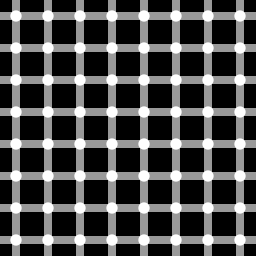 |
| Hermann Grid Illusion |
 |
| Mach Band Illusion |
Two famous optical illusions are shown above. In the Hermann Grid, it seems as though small black dots are dancing around in the white circles of the grid. In reality these black dots do not exist at all. In the Mach Band, it seems as though a small, bright stripe appears just before the gradient gets darker, and that a small, dark stripe appears just after the gradient gets darker. In reality these stripes don't exist. What is causing us to paint these imaginary images in the world?
Both of these optical illusions result from the receptive field organization of our retinal ganglion cells. RGC's are part of the light processing system of the retina in the back of our eyes, and are the last layer of cells in the retina before visual information starts to make its way to the brain. RGC's encode information about the visual world through a "center-surround" system. Consider the following schematic drawing of an RGC:

Basically, light that is present in the RGC's center excites the cell, and darkness in its surround excites the cell. For these reasons, this particular RGC is referred to as "on-center, off-surround". Thus, a cell of this type would be maximally excited by simultaneously having light in its center and dark in its surround. Now, consider how this type of organization comes into play with the Hermann Grid:

All three RGC's have light in their centers and dark in part of their surrounds, and thus have excitatory components. However, the RGC in the center of the grid has less dark in its surround than the neighboring RGC's, and thus it has a weaker response than the other two. The weaker the cell's response, the darker that particular area in space will be interpreted to be by our brain, as compared to cells with stronger responses, whose part of the world corresponding with their receptive field appears brighter. As a result, the space in the center of the grid is perceived to be darker than the surrounding white areas, giving rise to the illusion of a black dot. Similar forces are at work in the Mach Band.
There are many other types of optical illusions that are created by different weaknesses of our visual system. What is important to take from this is that the limitations of our biology prevent us from perfectly translating the physical world to our perception - what we perceive often is not what is actually there. The philosophical implications of this are quite profound. Does this mean that it is impossible for us to view reality in its truest form? Is there even such a thing?
No comments:
Post a Comment